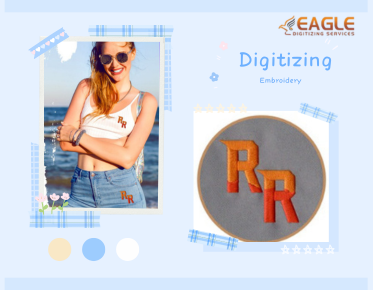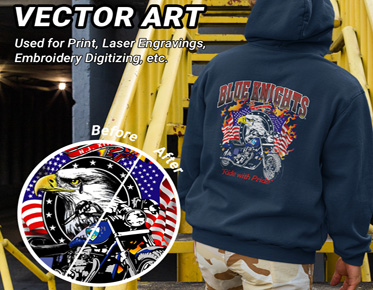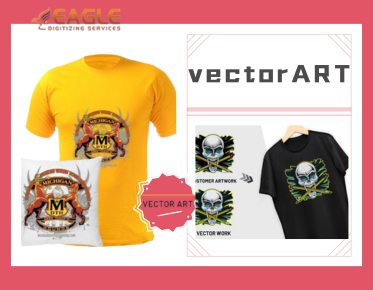Monogramming Made Simple with Pre-Made Designs/Eagle Digitizing
In a world where individuality is celebrated, monogramming stands out as a sophisticated and stylish way to personalize just about anything. Whether it's the initials on your favorite tote bag or the elegant lettering on your wedding napkins, monogramming adds a unique touch that transforms the ordinary into something special. This time-honored tradition has seen a resurgence, with pre-made designs making it easier than ever to bring a bespoke element to your belongings.Here are Some Essential Factors You Should Consider Regarding Embroidery Digitizing!
The Appeal of Monogramming: Personalizing Your World
Monogramming is more than just embellishment; it's a form of self-expression. Each monogram tells a story, encapsulating the essence of its owner in a beautifully crafted set of letters. This art form has transcended time, evolving from the regal emblems of royalty to the chic designs we see today. The allure of monogramming lies in its ability to take the mundane and make it extraordinary, offering a sense of ownership and pride that mass-produced items simply can't provide.
Why Pre-Made Designs are a Game-Changer
Gone are the days when creating a monogram was a lengthy and arduous process. Pre-made designs have revolutionized the world of monogramming, making it accessible to everyone, regardless of skill level. These designs, crafted by professionals, ensure that your monogram is not only aesthetically pleasing but also executed with precision. They save time, reduce the likelihood of errors, and open up a world of possibilities for those looking to add a personal touch to their items.
Why Choose Pre-Made Designs for Monogramming?
The Convenience Factor: Ready-to-Use Designs
One of the greatest advantages of pre-made designs is convenience. With a plethora of designs readily available, there's no need to spend hours crafting a monogram from scratch. These designs are ready to be applied to your chosen item, making the process quick and hassle-free. Whether you're working on a last-minute gift or personalizing your own belongings, pre-made designs save time while still delivering high-quality results.
Quality Assurance: Professional Designs vs. DIY
Pre-made monogram designs are often created by skilled designers who understand the nuances of typography, spacing, and symmetry. This expertise ensures that the final product is visually appealing and professionally executed. In contrast, DIY monograms, while rewarding, can sometimes lack the polish that comes with professional design. With pre-made designs, you can be confident in the quality and accuracy of your monogram.
Cost-Effective: Saving Time and Money
Pre-made designs are not only convenient but also cost-effective. They eliminate the need for expensive design software or hiring a custom designer. Additionally, because these designs are ready to use, you save valuable time, which is often as important as saving money. The result is a beautifully crafted monogram that doesn’t break the bank.
How to Select the Perfect Pre-Made Design
Matching the Design to Your Personality
Choosing a monogram design is a deeply personal process. The design should reflect your personality, whether that’s classic and understated or bold and adventurous. Take time to explore different styles, fonts, and layouts. A monogram is more than just initials—it’s an extension of who you are.
Considering the Occasion: Formal vs. Casual Monograms
The occasion plays a significant role in selecting a monogram. For formal events, such as weddings or corporate functions, a classic, elegant design is usually best. These might feature script fonts or intricate borders. For more casual occasions, playful fonts and creative layouts can add a fun, personalized touch. Matching the monogram to the tone of the event ensures it enhances rather than detracts from the overall aesthetic.
Color Schemes: Choosing Colors that Pop
Color is crucial in monogramming, as it can dramatically change the look and feel of the design. Contrasting colors make the monogram stand out, while monochromatic schemes create a subtle, sophisticated effect. Consider the background material as well—light colors on dark backgrounds or vice versa tend to work well. Don’t be afraid to experiment with unexpected color combinations to create something truly unique.
Fonts and Styles: Classic vs. Modern Looks
Fonts and styles are the heart of a monogram. Classic fonts, such as serifs or scripts, evoke a timeless elegance, perfect for traditional settings. Modern fonts, on the other hand, can give your monogram a contemporary edge, making it ideal for trendy or casual applications. The key is to choose a style that aligns with your taste and the message you want to convey.
Popular Materials for Monogramming with Pre-made Designs
Fabric Choices: From Cotton to Silk
Fabric is a popular medium for monogramming, offering a wide range of options from sturdy cotton to luxurious silk. Cotton is durable and easy to work with, making it a favorite for everyday items like bags and towels. Silk, with its smooth texture and sheen, is perfect for special occasions, adding a touch of elegance to items like handkerchiefs or pillowcases. The choice of fabric can enhance the overall impact of your monogram, so select one that complements the design.
Hard Surfaces: Wood, Glass, and Metal
Monogramming isn’t limited to fabric; hard surfaces such as wood, glass, and metal are also popular. Wooden monograms can be laser-cut or engraved, adding a rustic, natural touch to home décor or signage. Glass offers a sleek, modern look, perfect for items like glassware or mirrors. Metal monograms, often seen on jewelry or office supplies, provide a durable and sophisticated finish. Each material lends a different aesthetic, allowing for creativity in application.
Paper and Stationery: Elegant and Timeless Options
Paper products, such as stationery and invitations, are another excellent canvas for monogramming. These items are often associated with formal events, where a monogram can add a personalized and elegant touch. From embossed initials on wedding invitations to printed monograms on thank-you cards, the paper offers endless possibilities. The choice of paper—whether textured, glossy, or matte—can further enhance the visual impact of the monogram.
Top Tools and Techniques for Applying Pre-Made Designs
Embroidery Machines: Quick and Efficient
Embroidery machines have become the go-to tool for monogramming, especially when using pre-made designs. These machines can quickly and efficiently replicate intricate designs with precision. Modern embroidery machines offer various settings for different fabrics and thread types, ensuring that your monogram looks professional and lasts for years. The ease of use and speed make them an ideal choice for those who frequently monogram items.
Heat Transfer Vinyl: A Beginner’s Best Friend
For those new to monogramming, heat transfer vinyl (HTV) is a fantastic option. HTV allows you to apply pre-made designs to fabric with just an iron or heat press. It’s a simple process: cut the design, weed out the excess vinyl, and press it onto your fabric. The result is a crisp, clean monogram that’s durable and washable. HTV is particularly popular for t-shirts, bags, and other fabric items that require a bold, colorful monogram.
Hand-Stitching: Adding a Personal Touch
While machines offer convenience, hand-stitching a monogram adds a personal, artisanal touch. This technique requires more time and skill but results in a unique, one-of-a-kind piece. Hand-stitched monograms can vary in style, from simple backstitch designs to elaborate satin stitches. The tactile quality and the care that goes into hand-stitching make these monograms cherished keepsakes.
Digital Methods: Laser Cutting and Engraving
For hard surfaces like wood, glass, or metal, digital methods such as laser cutting and engraving are ideal. Laser technology allows for precise, intricate designs that are difficult to achieve by hand. Engraved monograms are long-lasting and can be applied to a wide range of items, from jewelry to home décor. Laser cutting is also excellent for creating custom shapes and designs, offering endless possibilities for creativity.
Tips for a Flawless Monogramming Experience
Prepping Your Material: The Importance of a Smooth Surface
Preparation is key to achieving a flawless monogram. Before applying your design, ensure that your material is clean and smooth. For fabrics, this might mean ironing out wrinkles or pre-washing to avoid shrinkage. For hard surfaces, cleaning and drying are essential to prevent dust or oils from interfering with the application. A well-prepped surface ensures that your monogram adheres properly and looks its best.
Aligning Your Design: Tips for Perfect Placement
Placement is critical in monogramming. Misaligned designs can throw off the entire look, so take time to measure and mark where your monogram will go. Tools like rulers, chalk, or temporary adhesive can help keep your design straight and centered. For fabrics, consider using a hoop or frame to hold the material taut. A little extra effort in alignment can make a significant difference in the final result.
Common Mistakes and How to Avoid Them
Even experienced crafters can make mistakes when monogramming. Common errors include choosing the wrong size for the monogram, misaligning the design, or not testing on a scrap piece of material first. To avoid these pitfalls, always double-check your measurements, do a test run if possible, and review your design before committing to the final application. Taking these precautions can save you time and frustration.
How to Care for Your Monogrammed Items
Washing and Drying Tips for Fabric Monograms
Caring for fabric monograms ensures they remain vibrant and intact for years. Always check the care instructions for both the fabric and the monogram. Generally, washing in cold water on a gentle cycle and air-drying is recommended to prevent the design from fading or distorting. Avoid using harsh detergents or bleach, as these can damage the fabric and the monogram. For delicate fabrics like silk, hand-washing is often the safest option.
Protecting Monograms on Hard Surfaces
Monograms on hard surfaces, such as wood or glass, require special care to prevent damage. Dust regularly with a soft cloth to keep the surface clean and free of debris. Avoid using abrasive cleaners or tools, which can scratch or dull the finish. For items like metal or glassware, consider applying a protective coating or sealant to preserve the monogram and extend the life of the item.
Repairing and Maintaining Monogrammed Pieces
Over time, monogrammed items may show signs of wear and tear. For fabric monograms, loose threads or fading can often be repaired with careful stitching or by reapplying the design. Hard surfaces may require touch-ups with paint or engraving tools. Regular maintenance, such as re-sealing or polishing, can also help keep your monogrammed items looking their best. Taking the time to care for these pieces ensures they remain cherished possessions.
Monogramming with pre-made designs opens up a world of creative possibilities. Monograms bring a unique blend of tradition and modernity to every project, whether adding a personal touch to your wardrobe, decorating your home, or elevating your business branding. Don't hesitate to try different ideas, materials, and processes. Whether you stick with classic styles or venture into new trends, the most important thing is to have fun and let your creativity shine!



